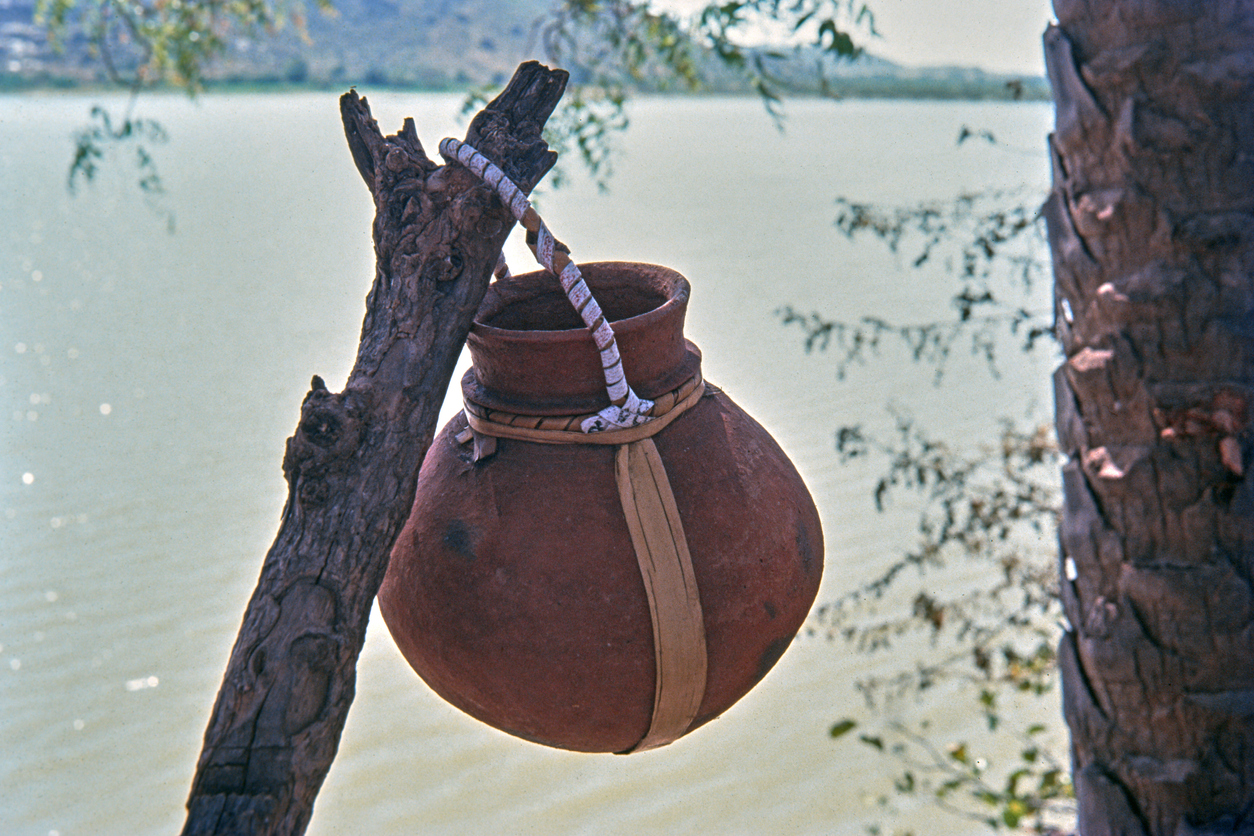The percentage of women who consume alcohol in Telangana is 24 times more than the corresponding figure in neighbouring Andhra and 49 times that of Tamil Nadu, according to the NFHS-5.

The unique clay pot which is used when collecting the nectar from the palm trees to make toddy Telangana. (iStock)
In the South Indian state of Telangana, around 4.9 percent of women, between the ages of 15 and 49 years, have said that they consume alcohol, according to National Family and Health Survey (NFHS-5) data.
In almost all other major North and South Indian states, less than 0.5 per cent of women said they consume alcohol. The national figure is 0.7 percent.
Telangana is only behind Northeastern states of Arunachal Pradesh, (17.8 percent), Sikkim (14.8 percent), and Assam (5.5 percent) when it comes to alcohol consumption by women.
Consumption of alcohol is generally considered a taboo in India. Talking about it openly, even when men do it, is seen as distasteful. This is more so when it comes to women consuming alcohol in India and talking about it.
Most surveys that deal with matters of social stigma, like alcohol and tobacco, are plagued by what is called a Social Desirability Bias.
It refers to the tendency of individuals to present themselves in a positive light, and to respond to questions in a manner that they believe will be viewed favourably by others — leading to under-reporting of such “bad” behaviour.
So what explains this social acceptability of alcohol consumption in Telangana, especially among women, who reported such behaviour in the NFHS-5?
“In Telangana, the consumption of kallu (toddy) has been prevalent since feudal times not just among women but men too,” Dr Rukmini Rao from the Gramya Resource Centre for Women told South First.
A study published in 2010, titled ‘Problem alcohol drinking in rural women of Telangana region, Andhra Pradesh’, in the Indian Journal of Psychiatry, found that 59 percent of women surveyed consumed toddy, while 40.8 percent consumed beer and whisky in addition to toddy.
In fact, Telangana Chief Minister K Chandrashekar Rao himself said in an interview on ABN news channel that consuming toddy together with his family was a daily practice that he grew up with.
Speaking to South First, Prof Bhangya Bhukya, subaltern historian with the Hyderabad Central University, noted that alcohol is “part of the food culture in Telangana where the husband and wife drink together”.
Stressing that this form of drinking should be seen as part of socialisation and not individual addiction, he said that the practice involves discussions about all aspects of life. “They share their difficulties, happiness, and sorrows, and find ways to live together as a community,” he said.
Highlighting the feudal roots of this practice to keep the working class pliant and dependent on the largesse of the feudal lord, Rao said that “alcohol was also used as a method of payment instead of cash”.
The toddy tapp,er community in Telangana is known by various names including Goud, Gamalla, and Gavandla. According to Bhukya, both men and women from the working-class communities usually congregate at the Eedhulu (where palm/toddy trees are cultivated by Gouds) after a hard day’s labour.
“Even women from the landed gentry consume toddy but in the refuge of their homes when Goud farmers deliver fresh munthalu (toddy containers) every evening,” he added.
Rao, who belongs to the Reddy community, said that she has seen this practice in her household growing up. “I come from a feudal family where dorasanis drank every evening,” she said.
Linking this to pantheistic religious practices common among tribal communities, Bhukya pointed out that this practice can be observed wherever there are predominantly tribal cultures.
“They celebrate festivals by making humble offerings of alcohol and meat to the Mother Goddess. We can observe this during Bonalu and Muthyalamma festivals too,” he pointed out.
The NFHS-5 figures show that in adjoining states with a relatively high tribal population such as Chhattisgarh (2.8 percent), Odisha (2.7 percent), and Jharkhand (2.6 percent), consumption of alcohol by women is above India’s national figure of 0.7 percent.
“In fact, this observation can be extended to the Northeastern states too — where tribal culture predominates — all of which have figures higher than the national average,” Bhukya added.
Sujatha Surepally, professor of sociology at Satavahana University in Karimnagar, cautioned that highlighting only consumption among women might lead to dangerous stereotyping.
“You should highlight the amount of alcohol consumed by the Telangana menfolk too. Otherwise, there is a danger of isolating women, especially rural working-class women,” she told South First.
According to the NFHS-5 data, 50 percent of men between the ages of 15 and 49 years in Telangana have said they consume alcohol. Only Arunachal Pradesh and Goa have higher numbers.
In fact, this figure is at least 10 percentage points higher than all other major states in India and more than twice the national figure of 22.7 percent.
Since disaggregated data is unavailable, it is difficult to say with certainty the urban-rural detail of this consumption.
“Most urban consumption, I think, is from Hyderabad. You go to any pub, and you’ll see women drinking freely,”, Surepally pointed out. “But most of them are youngsters. Whereas in rural areas you see elderly women partaking in the consumption too.”
Rao agrees with Surepally’s assessment and added that talking about certain communities in Telangana consuming alcohol, especially from rural areas, can also lead to them being viewed in bad light unnecessarily.
“I think women everywhere drink; some more, some less. What we should stress is that in the case of these communities, there is no hypocrisy. In fact, this reflects in a sense the level of social progress women enjoy in these communities,” she emphasised.

Apr 23, 2024

Apr 23, 2024

Apr 22, 2024

Apr 22, 2024

Apr 22, 2024